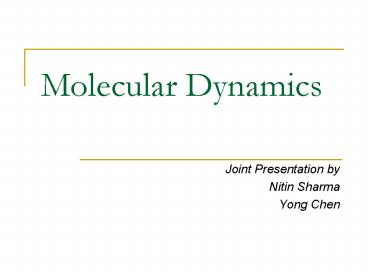Molecular Dynamics - PowerPoint PPT Presentation
1 / 10
Title:
Molecular Dynamics
Description:
Main steps in molecular dynamics simulations. Discussion of results ... A motion picture that follows molecules as they dart to & fro, twisting, turning, ... – PowerPoint PPT presentation
Number of Views:349
Avg rating:3.0/5.0
Title: Molecular Dynamics
1
Molecular Dynamics
- Joint Presentation by
- Nitin Sharma
- Yong Chen
2
- Introduction
- Brief overview of Molecular Dynamics Simulations.
- Principal steps involved
- Main steps in molecular dynamics simulations
- Discussion of results
- Some simulation results will be presented by Yong
3
What is Molecular Dynamics Simulation ?
- A motion picture that follows molecules as they
dart to fro, twisting, turning, colliding with
one another.
4
Principal steps involved
- Construction of a model
- Calculation of molecular trajectories
- Analysis of those trajectories to obtain property
values.
5
Construction of a model
- Model for molecular interactions
- Intermolecular force law or equivalently an
intermolecular potential energy function. - Model for system environment interactions.
- Periodic boundary conditions are used for bulk
fluid - For simulations in which surface effects are to
be analyzed interaction of the liquid molecules
with the solid surface molecules are considered.
6
Hard Sphere
u(r)
r
r1r2
Soft Sphere
is determined by the equilibrium distance
is the depth of the potential
Lennard-Jones Potential
7
Calculation of Molecular Trajectories
- Positions are obtained by numerically solving the
differential equation of motions (Newtonian
dynamics) - Algorithms for Molecular Dynamics
- Verlets Algorithm
- General Predictor-Corrector Algorithms
8
Verlets Algorithm
- Third order in time accuracy
- Two step method estimates x(tdt) from the
current position x(t) and the previous position
x(t-dt) - Not self starting
- Simple, stable for moderately large time steps.
- (time step should be large enough to sample
large phase space, should be small compared to
mean time between collisions)
9
General-Predictor Corrector Algorithms
- Predict the position x(tdt) and velocity v(tdt)
at the end of the next step. - Evaluate the forces at tdt using the predicted
position. - Correct the predictions using some combination of
the predicted and previous values of position and
velocity.
10
Analysis of trajectories to obtain property values
- Systems at equilibrium
- Isolated system containing fixed energy, number
of molecules volume (NVE-molecular dynamics) - Time averages of the properties can be computed
once the system has relaxed to equilibrium. - Systems at non-equilibrium
- External force applied to the system
- Used to compute transport coefficients, shear
viscosity, bulk viscosity, thermal conductivity
and diffusion coeffcient.































